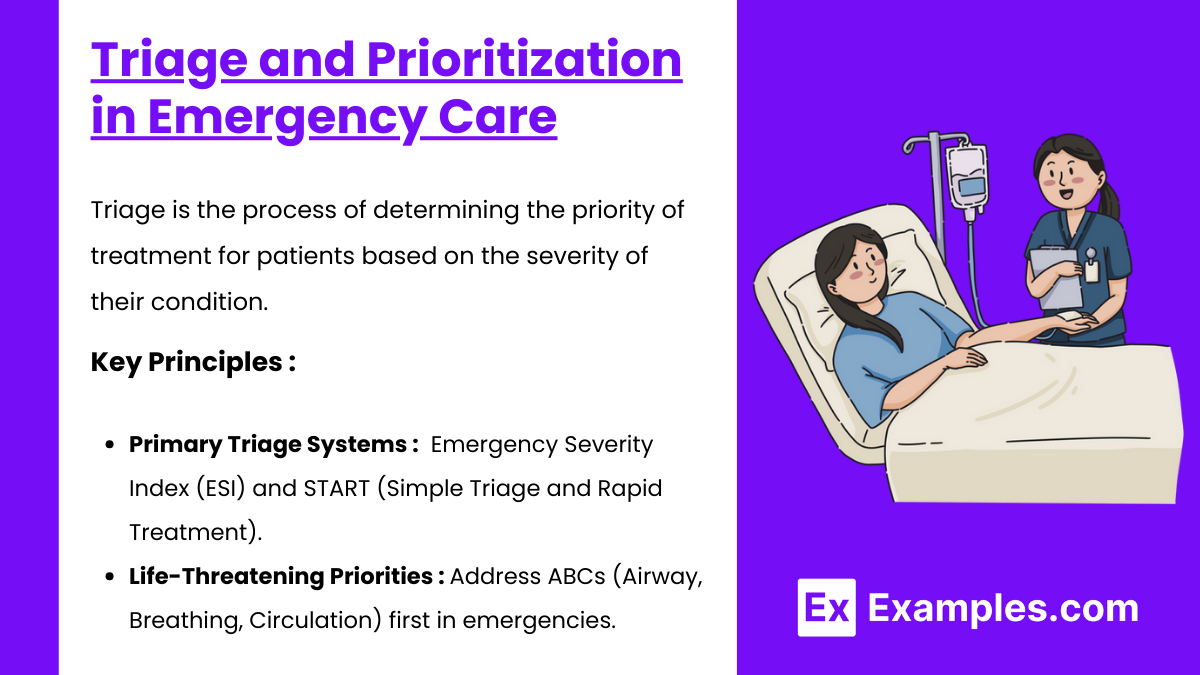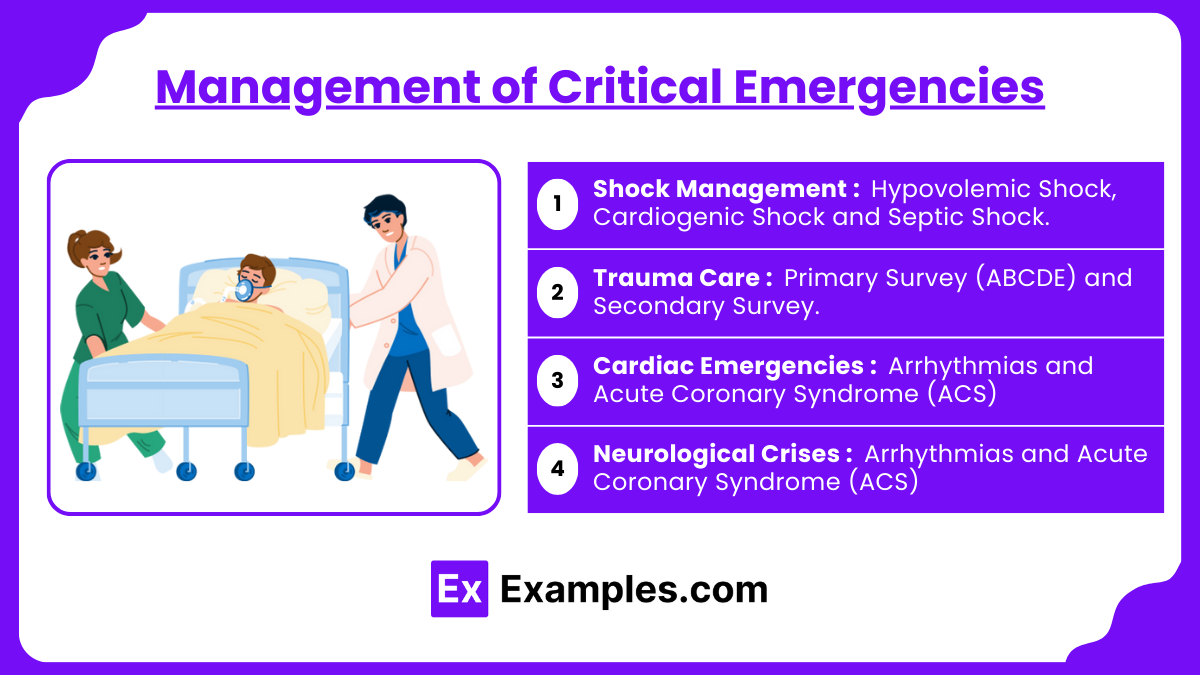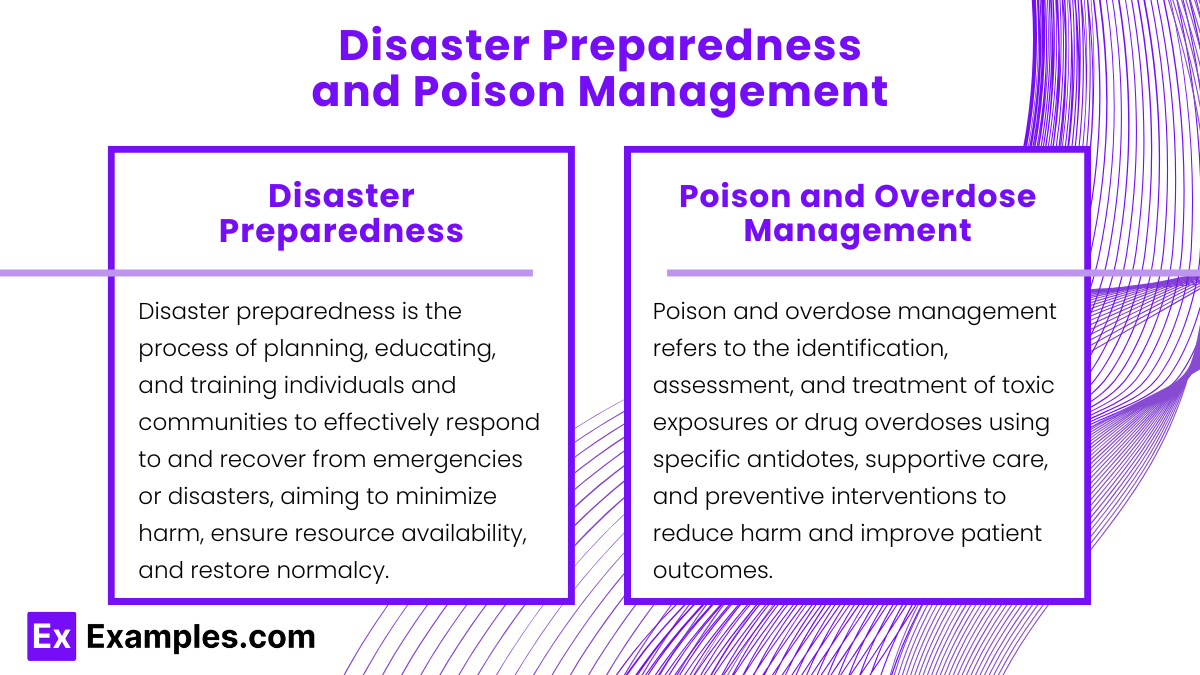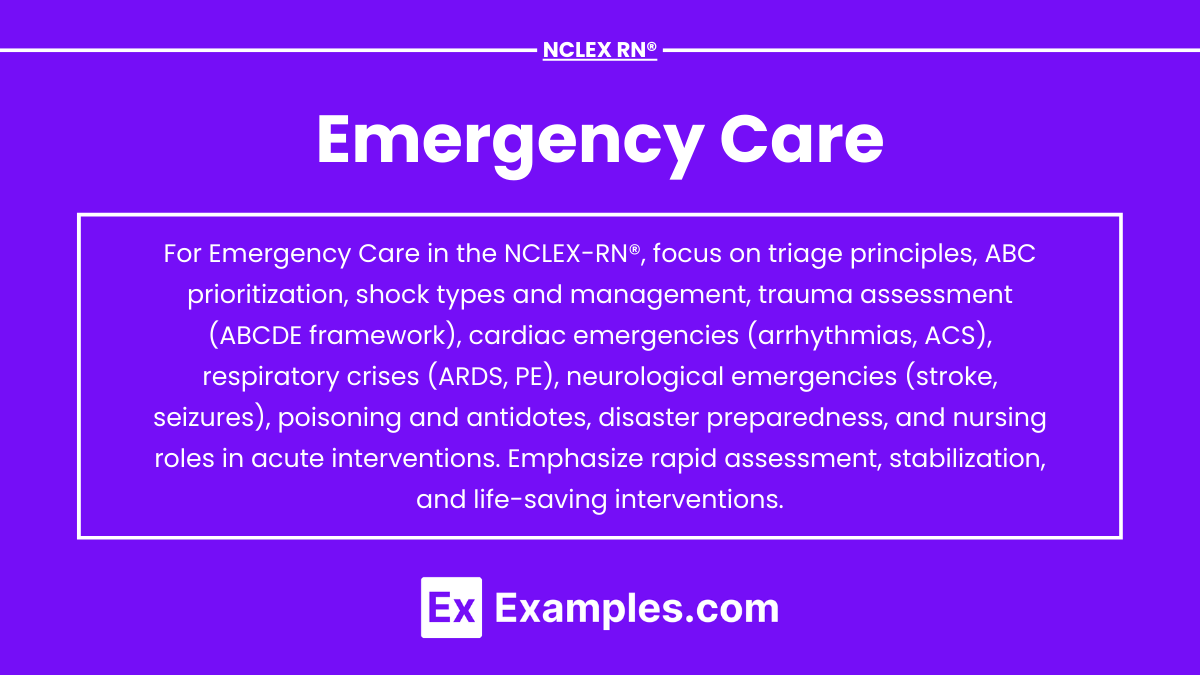Emergency care in critical settings is a cornerstone of nursing practice, focusing on rapid assessment, stabilization, and management of life-threatening conditions. For the NCLEX-RN®, this topic emphasizes the ability to prioritize care, apply the ABC framework (Airway, Breathing, Circulation), and implement evidence-based interventions in urgent scenarios. From trauma and cardiac emergencies to neurological crises and poison management, understanding these principles is essential. Success in this area showcases your critical thinking, prioritization, and quick decision-making skills, preparing you to excel in high-pressure clinical environments.
Learning Objectives
In studying “Critical Care: Emergency Care” for the NCLEX-RN® exam, you should learn to understand the principles of triage, prioritization, and life-saving interventions in acute situations. Evaluate techniques for airway management, shock stabilization, and trauma care using the ABCDE framework. Analyze the protocols for cardiac emergencies, neurological crises, and respiratory failure. Explore how tools like ACLS algorithms, disaster management strategies, and poisoning antidotes are applied in clinical scenarios. Develop the ability to interpret patient presentations, prioritize care effectively, and implement rapid interventions, ensuring patient safety. Apply your understanding to answer NCLEX-style questions focusing on emergency care and critical thinking.
1. Triage and Prioritization in Emergency Care

Triage is the process of determining the priority of treatment for patients based on the severity of their condition. Nurses play a pivotal role in triage, ensuring that resources are allocated efficiently to those who need them most.
Key Principles:
- Primary Triage Systems:
- Emergency Severity Index (ESI): Categorizes patients into five levels based on urgency and resource needs.
- START (Simple Triage and Rapid Treatment): Used during mass casualties to classify patients into four categories: Minor, Delayed, Immediate, and Deceased.
- Life-Threatening Priorities:
- Address ABCs (Airway, Breathing, Circulation) first in emergencies.
- Ensure rapid interventions like securing the airway, providing oxygen, and controlling hemorrhages.
Example: A patient with severe respiratory distress and declining oxygen saturation takes precedence over one with a minor laceration.
2. Management of Critical Emergencies

Effective management of critical emergencies involves rapid assessment, stabilization, and intervention. Each scenario demands a specific set of actions to ensure the best possible outcomes for patients.
1. Shock Management:
- Hypovolemic Shock: Rapid fluid resuscitation with crystalloids (e.g., normal saline).
- Cardiogenic Shock: Supportive care with vasopressors (e.g., norepinephrine) and inotropes (e.g., dobutamine).
- Septic Shock: Administer antibiotics within the first hour and ensure fluid resuscitation.
2.Trauma Care:
- Primary Survey (ABCDE):
- Airway management with cervical spine protection.
- Assess for life-threatening chest injuries (e.g., tension pneumothorax).
- Control external bleeding and maintain adequate perfusion.
- Secondary Survey:
- Conduct a thorough head-to-toe assessment, including imaging and laboratory tests.
3.Cardiac Emergencies:
- Arrhythmias:
- Use ACLS protocols to treat life-threatening rhythms like VFib (defibrillation) or SVT (adenosine).
- Acute Coronary Syndrome (ACS):
- Follow MONA (Morphine, Oxygen, Nitroglycerin, Aspirin).
4.Neurological Crises:
- Recognize signs of stroke early and initiate fibrinolytics for ischemic strokes.
- Protect patients during seizures and administer benzodiazepines for status epilepticus.
3. Disaster Preparedness and Poison Management

Disaster scenarios and poisoning cases are integral to emergency care, testing your ability to act swiftly and efficiently under pressure.
Disaster Preparedness: Disaster preparedness is the process of planning, educating, and training individuals and communities to effectively respond to and recover from emergencies or disasters, aiming to minimize harm, ensure resource availability, and restore normalcy.
- Phases of Disaster Management:
- Preparedness: Educate and train for disasters, ensure resource availability.
- Response: Triage and provide immediate care.
- Recovery: Reintegrate services and manage long-term effects.
- Roles of Nurses in Disasters:
- Conduct triage using the START system.
- Administer first aid and psychological support to victims.
Poison and Overdose Management: Poison and overdose management refers to the identification, assessment, and treatment of toxic exposures or drug overdoses using specific antidotes, supportive care, and preventive interventions to reduce harm and improve patient outcomes.
- Common Poisons:
- Opioid Overdose: Administer naloxone and monitor respiratory function.
- Carbon Monoxide Poisoning: Provide 100% oxygen or hyperbaric oxygen therapy.
- Household Chemicals: Ensure safety precautions and administer antidotes when available.
Examples
Example 1. Prioritizing Care in a Multi-Trauma Scenario
During a mass casualty event, the nurse must triage multiple patients using the START system. A patient with an open airway, rapid breathing, and signs of shock is categorized as “Immediate” and prioritized over a patient with minor abrasions. The NCLEX-RN® may present this type of question to evaluate your ability to use triage principles and prioritize care effectively under pressure.
Example 2. Managing an Acute Myocardial Infarction (MI)
A 58-year-old patient presents to the emergency department with chest pain radiating to the left arm, diaphoresis, and nausea. The nurse quickly administers oxygen, ensures IV access, and provides aspirin, nitroglycerin, and morphine per protocol (MONA). The nurse also prepares the patient for possible PCI. This scenario tests the nurse’s ability to recognize MI symptoms and implement timely interventions to reduce myocardial damage.
Example 3. Responding to a Stroke Emergency
A patient arrives with sudden weakness on one side, slurred speech, and facial drooping. The nurse conducts a rapid assessment using the FAST tool and ensures immediate transport to a facility equipped for thrombolytic therapy. The NCLEX-RN® may evaluate your knowledge of time-sensitive interventions, such as initiating fibrinolytics within the recommended 3-4.5 hours for ischemic stroke.
Example 4. Treating Respiratory Distress in a Pediatric Patient
A 4-year-old child is brought in with severe respiratory distress, nasal flaring, and stridor. The nurse ensures airway patency by positioning the child upright and administers nebulized epinephrine. Oxygen therapy and corticosteroids are initiated as ordered. This scenario highlights the nurse’s role in managing pediatric emergencies and understanding age-specific interventions.
Example 5. Addressing a Hypovolemic Shock Situation
A patient experiencing hypovolemic shock due to severe gastrointestinal bleeding presents with low blood pressure, tachycardia, and cold, clammy skin. The nurse immediately establishes large-bore IV access, administers isotonic fluids, and prepares the patient for blood transfusion. Monitoring urine output and vital signs ensures the effectiveness of interventions. The NCLEX-RN® tests the ability to manage shock efficiently, focusing on life-saving measures and fluid resuscitation.
Practice Questions
Question 1
A nurse in the emergency department is triaging four patients. Which patient should the nurse prioritize for immediate care?
A. A 45-year-old with chest pain rated 4/10, normal vital signs, and no previous cardiac history.
B. A 3-year-old child with a fever of 101.5°F (38.6°C) and mild dehydration.
C. A 67-year-old with slurred speech, facial drooping, and right arm weakness that started 30 minutes ago.
D. A 23-year-old with a sprained ankle and moderate swelling.
Answer: C. A 67-year-old with slurred speech, facial drooping, and right arm weakness that started 30 minutes ago.
Explanation:
- The patient in Option C exhibits classic signs of an ischemic stroke (slurred speech, facial drooping, and weakness). Early intervention, such as fibrinolytic therapy, is critical and should be administered within the 3-4.5-hour window. This makes this patient the highest priority.
- Option A: While chest pain could indicate a cardiac event, the pain level is low, and vital signs are stable. This patient is not the immediate priority compared to a potential stroke.
- Option B: The child has a fever and mild dehydration, which can be managed with fluids and fever reduction.
- Option D: A sprained ankle is non-urgent and can wait for care after more critical cases are addressed.
Question 2
A patient is brought to the emergency department after a motor vehicle collision. The patient is unconscious with snoring respirations. What is the nurse’s first action?
A. Suction the airway to remove secretions.
B. Perform a jaw-thrust maneuver.
C. Insert a nasopharyngeal airway.
D. Prepare for endotracheal intubation.
Answer: B. Perform a jaw-thrust maneuver.
Explanation:
- The jaw-thrust maneuver is the first action to open the airway in a trauma patient with potential cervical spine injury. It is a safe technique that avoids moving the neck, preventing further spinal damage.
- Option A: Suctioning may be necessary, but the snoring respirations suggest partial airway obstruction that requires immediate correction with a jaw-thrust.
- Option C: Inserting a nasopharyngeal airway may help maintain patency but should be done only after ensuring the airway is open.
- Option D: Endotracheal intubation may be necessary if the jaw-thrust maneuver does not maintain the airway, but it is not the initial step.
Question 3
A nurse is caring for a patient in hypovolemic shock. Which intervention should the nurse perform first?
A. Administer a vasopressor such as norepinephrine.
B. Obtain a blood sample for laboratory testing.
C. Start an IV infusion of 0.9% normal saline.
D. Place the patient in the Trendelenburg position.
Answer: C. Start an IV infusion of 0.9% normal saline.
Explanation:
- The priority in managing hypovolemic shock is to restore intravascular volume. Administering 0.9% normal saline rapidly improves circulation and perfusion.
- Option A: Vasopressors like norepinephrine are used after fluid resuscitation if blood pressure remains low. Starting vasopressors without addressing volume loss can worsen tissue perfusion.
- Option B: Obtaining blood samples is important but not the priority. It can be done simultaneously while resuscitation efforts are underway.
- Option D: The Trendelenburg position is not recommended as it does not significantly improve circulation and may impair respiratory function.


